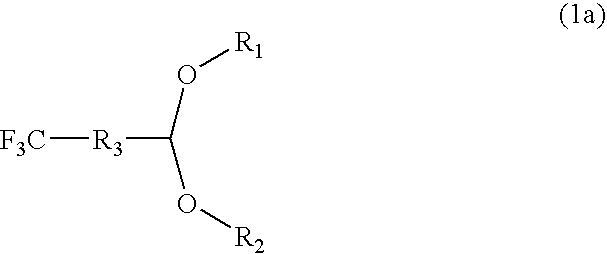Fluorine-containing polymer coating composition, method for forming fluorine-containing polymer film using coating composition, and method for forming photoresist or lithographic pattern
- Summary
- Abstract
- Description
- Claims
- Application Information
AI Technical Summary
Benefits of technology
Problems solved by technology
Method used
Image
Examples
synthetic example 1
[0086] Synthesis of Fluorinated Acetal (A)
[0087] Into a 300 mL stainless-steel autoclave cooled with dry ice and acetone was charged a solution of 25.8 g (0.46 mol) of KOH dissolved in 52.5 g (0.69 mol) of 1,3-propanediol and 4.2 g of water beforehand and 30 g (0.23 mol) of (1Z)-1-chloro-3,3,3-trifluoropropene. After temperature was elevated to around 20° C., the whole was stirred for 1 hour and then heated under stirring at 88° C. for 10 hours. When the reaction solution was measured by gas chromatography, other than excess 1,3-propanediol, it contains 1.0% of starting (1Z)-1-chloro-3,3,3-trifluoropropene, 82.0% of 2-(2,2,2-trifluoroethyl)-1,3-dioxane, and 17.0% of others.
[0088] After precipitated salts were filtered off, a fraction of 76° C. to 78° C. / 16 kPa was collected by distillation to obtain 21.5 g (purity 99%, yield 54.4%) of 2-(2,2,2-trifluoroethyl)-1,3-dioxane (fluorinated acetal (A)).
[0089] Boiling point: 137° C.
[0090] Flash point: 41.0-41.5° C.
synthetic example 2
[0091] Synthesis of Fluorinated Acetal (B)
[0092] Into a 1 L stainless-steel autoclave cooled with dry ice and acetone was charged a solution of 86 g (1.53 mol) of KOH dissolved in 237 g (7.40 mol) of methanol and 10 g of water beforehand and 100 g (0.77 mol) of (1Z)-1-chloro-3,3,3-trifluoropropene. After temperature was elevated to around 22° C., the whole was stirred for 1 hour and then heated under stirring at 70° C. for 1.5 hours. When the reaction solution was measured by gas chromatography, other than excess methanol, it contains 2.0% of starting (1Z)-1-chloro-3,3,3-trifluoropropene, 83.6% of (1Z)-3,3,3-trifluoro-1-methoxypropene, 10.3% of (1E)-3,3,3-trifluoro-1-methoxypropene, and 4.1% of 1,1,1-trifluoro-3,3-dimethoxypropane.
[0093] After precipitated salts were filtered off, a fraction of 80° C. to 110° C. was collected by flush distillation to obtain 190 g of a mixture. Into the resulting mixture was charged 16.5 g of methanesulfonic acid (0.172 mol), followed by heating u...
synthetic example 3
[0097] Synthesis of Fluorinated Acetal (C)
[0098] Into a 300 mL stainless-steel autoclave cooled with dry ice and acetone was charged a solution of 38.7 g (0.69 mol) of KOH dissolved in 71.4 g (1.15 mol) of ethylene glycol beforehand and 30 g (0.23 mol) of (1Z)-1-chloro-3,3,3-trifluoropropene. After temperature was elevated to around 22° C., the whole was stirred for 1 hour and then heated under stirring at 60° C. for 4 hours. When the reaction solution was measured by gas chromatography, other than excess ethylene glycol, it contains 2.0% of starting (1Z)-1-chloro-3,3,3-trifluoropropene, 80.0% of 2-(2,2,2-trifluoroethyl)-1,3-dioxolane, and 18.0% of others.
[0099] After precipitated salts were filtered off, a fraction of 80° C. to 100° C. / 13 to 16 kPa was collected by distillation to obtain 19.1 g (purity 99%, yield 53.2%) of 2-(2,2,2-trifluoroethyl)-1,3-dioxolane (fluorinated acetal (C)).
[0100] Boiling point: 120° C.
[0101] Flash point: 33.0-33.5° C.
PUM
 Login to View More
Login to View More Abstract
Description
Claims
Application Information
 Login to View More
Login to View More - R&D
- Intellectual Property
- Life Sciences
- Materials
- Tech Scout
- Unparalleled Data Quality
- Higher Quality Content
- 60% Fewer Hallucinations
Browse by: Latest US Patents, China's latest patents, Technical Efficacy Thesaurus, Application Domain, Technology Topic, Popular Technical Reports.
© 2025 PatSnap. All rights reserved.Legal|Privacy policy|Modern Slavery Act Transparency Statement|Sitemap|About US| Contact US: help@patsnap.com



